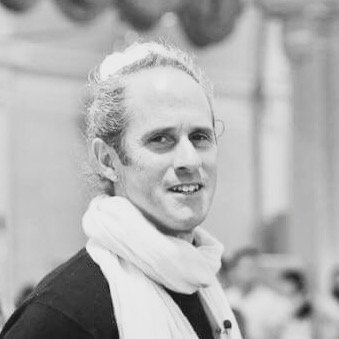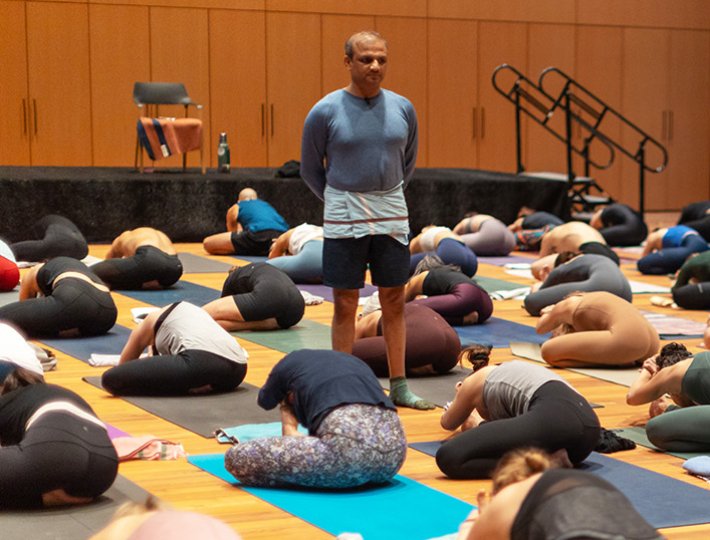A specific breathing technique is central to the vinyāsa method that is the foundation of the Aṣṭāṅga yoga method of Pattabhi Jois. Jois stressed the importance of this and would often quote Vāmana Rṣi from the Yoga Korunta: “Vinā Vinyāsa yogena āsanādih na kārayet,” which translates to “Do not do yoga without vinyāsa.”
This breathing technique, combined with vinyāsa and postures, allows the blood to circulate properly, remove toxins and make the body light and strong. It also automatically corrects internal alignment. When the breath becomes even and smooth, the nervous system is also purified, resulting in a calm mind. This is when transformation through practice becomes possible.
To fully understand this technique and integrate it into one’s practice, one must learn how to execute this correctly with guidance from an experienced teacher. The following article isn’t meant to teach you this skill, but rather share insights with you on the process and its benefits.
The Role of Mūla & Uḍyāṇa Bandhas in the Ashtanga Breathing Technique
The breathing technique employed in Aṣṭāṅga yoga is quite different compared to the usual, unregulated breathing we do every day. Requiring the use of the mūla and uḍyāṇa bandhas, the technique completely alters the way our diaphragm moves. In order to discuss the technique, it is vital to to understand, at least conceptually, what bandha means. The Yoga Mala of Pattabhi Jois describes it: “Mūla bandha…means lifting the anus up towards the navel. Uḍyāṇa bandha…means the lifting of the core muscles four inches below the navel.”
When asked by students, however, I have heard both Pattabhi Jois and his grandson Sharath state that mūla bandha means “squeezing” or “tightening the anus,” and uḍyāṇa means drawing the lower waist in tightly. In normal unregulated breathing without application of the bandhas, the diaphragm moves downwards and displaces the lower abdominal organs, causing the lower abdomen to protrude outward. In this kind of breathing, there is very little lateral movement of the ribs with most movement seen in the abdomen.
Conversely, during inhalation in Aṣṭāṅga yoga, the action of squeezing the anus (mūla bandha) and contracting the lower abdominal muscles (uḍyāṇa bandha) prevents the lower abdominal organs from moving downward. Instead the abdominal organs resist the downward movement of the diaphragm and cause it to cantilever out and to expand laterally. This lateral expansion of the diaphragm requires movement of the lower ribs, which also expand outwardly along with a lifting of the chest. The result is very deep breathing, which efficiently accesses all parts of the lungs when perfected.
RELATED: Sharath Jois on the Importance of Breathing in Yoga
The opposite happens during exhalation as the diaphragm returns to its original position. It’s important to practice this form of breathing in simple āsanas before it can be applied to more difficult postures. When the technique has been mastered, practicing it consistently not only increases the efficiency of breathing, but also helps lengthen and support the spine, correct internal alignment, and create conditions for improved mobility and support in all directions of movement. This type of conscious breathing combined with the use of the bandhas, strengthens and tones the pelvic floor, lower abdominal muscles, diaphragm and intercostal muscles. An overall improvement in breathing will also carry over to habitual breathing patterns throughout the day.
Understanding the Quality of Breath
Pattabhi Jois repeatedly used the phrase “free breathing with sound” when referring to how we should breathe in āsana practice. By this, he meant that we should not restrict the breathing channel in the throat, but instead let the breath flow easily in and out of the lungs. The soft sound that is sometimes heard comes from deep within the chest rather than from a restriction in the throat.
In practice, you should aim to keep the inhales and exhales the same length and of even intensity throughout each cycle of breath. Jois also regularly stated that the āsana (posture) is only correct once the breathing is correct. In other words, until the practitioner can breathe freely and without restriction in a particular āsana, he or she has not yet mastered that āsana. The quality of the breath and the quality of the mind reflect each other. When breathing is smooth, deep and balanced, the mind tends to be calm and steady.
The Benefits of Breathing Correctly
Perfection of the breathing technique results in a more efficient uptake of oxygen and the removal of carbon dioxide. The practice of even, smooth breathing also has a profound effect on the nervous system, helping to balance out highs and lows and bringing more stability physically, mentally and emotionally throughout the day. This results in greater clarity and calmness of mind, which is extremely important for success in yoga.
Since breath is intimately connected to physical, mental and emotional states, it is possible to use breathing techniques to regulate the system. For example, the breath becomes irregular during emotional upheaval, excitement or stress. Amazingly, you can significantly improve stress levels and emotional disturbance by consciously controlling your breathing during these times. Simply taking a few deep, even breaths can shift your mood significantly.
Breath is also profoundly linked to physical condition. By practicing the breathing technique in the context of vinyāsa and āsanas, the development of a strong, healthy breathing system improves overall wellbeing and supports increased vitality and mental clarity. As cited in ancient texts and experienced firsthand, breathing is intimately related to the flow of energy (prāṇa or life force) within the body. Prāṇa is responsible for managing many different functions in the body. When prāṇa flows freely, there is good health. But when free circulation is restricted, it can result in disease. Healthy breathing patterns are important to help to keep prāṇa flowing correctly. It is also “prāṇā which is the unifying factor between the individual spirit (or jīvātman) and the Supreme Being (Paramātman)” and “practicing the control of prāṇa becomes vital in this process,” wrote Krishnamacharya in Yoga Makaranda.
Prāṇāyāma, the fourth limb of Aṣṭāṅga yoga, is the link from the first three limbs (yama, niyama, āsana) to the higher stages of consciousness. The method of Aṣṭāṅga yoga first stabilizes the body and mind through daily practice of the these first three limbs with attention on deep and even diaphragmatic breathing, which is in itself a foundational prāṇāyāma. More advanced breathing techniques are only introduced once the practitioner has become stable both physically, mentally, and emotionally through consistent practice over a long period of time (and should only be attempted under the guidance of a very experienced teacher.)
In Yoga Mala, Pattabhi Jois quotes a warning from the Hatha Yoga Pradipika, “Just as a lion, elephant or tiger may be gradually brought under control, so is prāṇā attended to, otherwise, it destroys the practitioner.” By first building a strong foundation in your practice with attention on breathing correctly, the later limbs will unfold more easily and without danger.
Photography by Agathe Padovani









Comments (0)